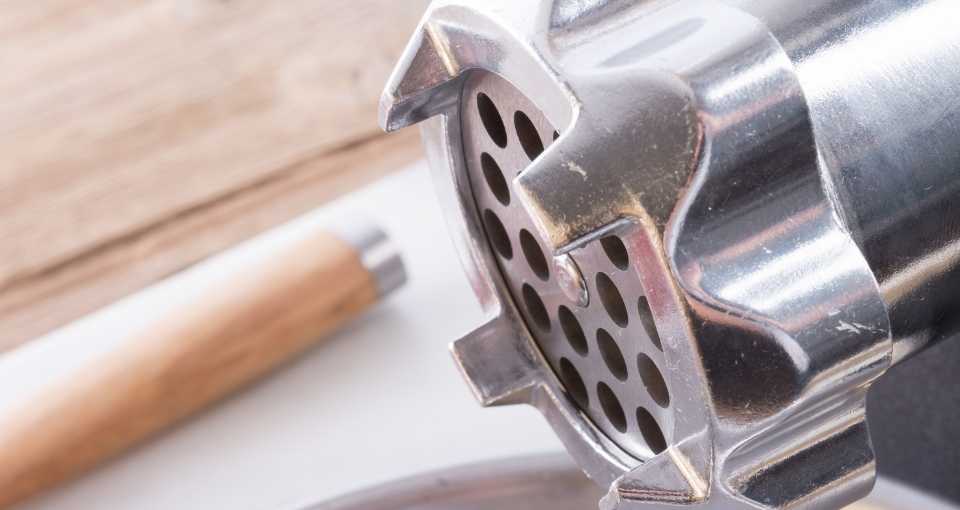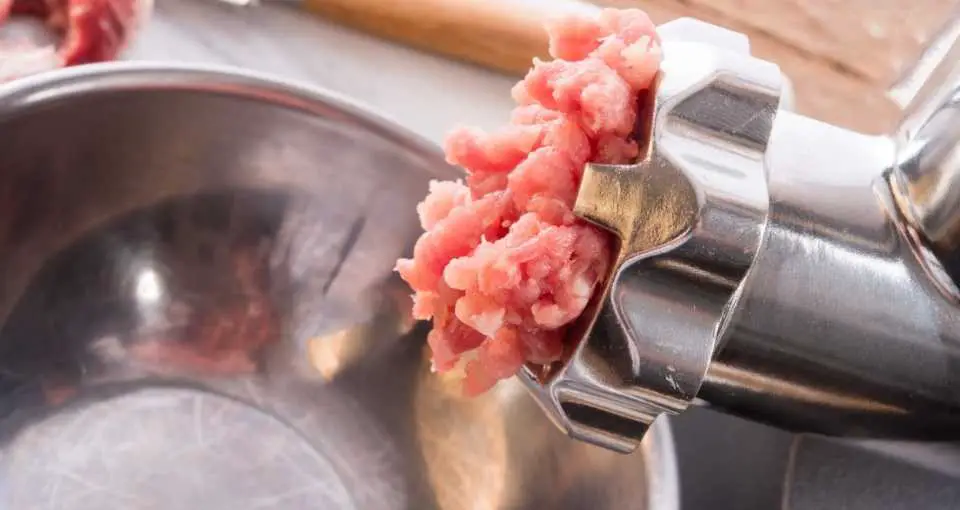The act of making sausages is fairly straightforward. All you’re doing is running meat through a grinder. Then taking that ground meat and stuffing it into sausage casings.
While the process isn’t complicated there is a lot of preparation involved to make the best sausages. It really is an art form making good sausages.
Most of the hard work comes in the preparation stage of making sausages.
So I put together as much helpful information here to help get you started on your journey to making homemade sausage.
How To Prepare and Grind Sausage Meat
Grinding sausage meat starts with picking out your choice of meat cut. It is always recommended to have a good meat to fat ratio. Usually this means about 30 – 40% fat to lean meat.
Read more: Best Meat Cuts For Making Sausage (Beef & Pork).
Remember after cutting up your meat it is likely you will discard unwanted pieces. Tendons, sinew and any remaining skin are the parts you are going to be trimming off.
Working with clean pieces of meat and fat goes along way once you begin grinding. Its best to remove anything that is going to jam up your blade. Besides that these pieces are not something you want in your sausage.
So keep this in mind to make sure you have enough meat for your sausages. The best estimate is you will get about 6 sausages per pound of meat (source).
An 8 pound cut of meat can turn out to be only 6 pounds after trimming for example.
Once you have your meat purchased and ready, all you need to do is begin slicing down the cut. You want to make it into smaller pieces that can be easily fed into your grinder.
Cutting the meat down into smaller pieces also makes seasoning much more effective. As it doesn’t take as long for each slice to absorb the flavors.
How Much Salt To Put In Homemade Sausage?
Salt is not only important in flavoring sausage meat, it also retains moisture while cooking, cures the meat and acts as binder. So it has many helpful functions.
Most importantly you want to add enough salt, buts its easy to over do it.
I have found the general rule for how much salt to add into sausage meat is about 1.5 to 2 % by weight. That means out of the total weight of sausage meat you intend to use. About 1.5 to 2% of that is going to be salt.
No wonder there is so much sodium in some meat products! You Ever looked at how much is in a stick of beef jerky?
1.5 to 2% salt is of course a rule of thumb and you can tweak that amount to your tasting. When you are adding additional ingredients into your sausage that might have sodium already you can lower that percent.
It helps to have a food scale because you are going to need to do some math.
First convert the weight of your meat from pounds to grams. Then take that number and multiply it by .015 (1.5%) or .02 (2%). That number will be the total amount in grams of how much salt you should use.
Example: 5 pounds of meat = 2267.96 grams. 2267.96 x .015 = 34 grams of salt. Kosher salt is the best type to use mainly because the flavor is more neutral compared to iodized salt. Kosher salt believe it or not is less salty tasting when it comes to cooking.
Lets talk about pink salt for a moment because I’m not going to go into much detail about using it for now. Pink salt is used for curing sausages and you really only need it if you plan to cold smoke your sausages.
Now your ready to add your seasoning to the sliced meat. Have the meat ready in a bowl or container. Then just dump the seasoning in and stir it in thoroughly, lets go into more detail…
Seasoning Sausage Meat
Now for the seasoning and this is where you can get creative. There is many options to choose from when it comes to seasoning. If you want to make this step easy then just put in a ready to use sausage seasoning mix.
Pick out one of the best sausage seasoning mixes on Amazon here.
Like I mentioned there is many spices that can be used in sausage meat. Here is some ideas…cayenne pepper, garlic powder, onion powder, Italian seasoning, red pepper flakes and fennel seed.
Certain seeds you might not want crushed. So you can add in fennel for example after grinding.
Read more: 7 Seed Varieties Used In Sausage Making
Season Sausage Before or After Grinding?
This is a fairly common question and isn’t as much as a debate, but rather a subject of sharing techniques among sausage making enthusiasts.
You can season sausage meat before you grind or after. Either way your going to be mixing in the seasoning by hands or with a meat mixer at some point.
Really it is a matter of preference or how you were taught. Some methods involve a first grind, season the meat and then grind it one more time.
Adding Binders To Sausage
You can also at this point begin considering what type of binder you are going to use for the sausage. Binders aren’t required because in most cases if you got enough fat it will act as a natural binder.
But some folks swear by using a binder, saying you will achieve a much juicier sausage. Since it will help to retain moisture and also help with the overall texture.
How Do You Bind Sausages?
Binding sausages is done with an additional ingredient which acts to hold fat and meat together. A binder or binding agent works by helping to emulsify fat, meat and proteins which otherwise don’t hold together well. The binder is added and mixed well into the meat before stuffing the sausages.
Soy protein, milk powder or even bread crumbs are commonly used.
Learn more: Best Binders for Making Homemade Sausage
Chilling Meat Before Grinding
Considering you bought the meat and brought it home as soon as possible. It will be still cool from where it was stored. But in the time it can take to trim and slice it up. The meat can become warmer.
So you are going to want to chill the meat again after cutting it up. The reason is you want to grind cold meat.
Grinding meat works much better when the meat has been chilled.
That is the main reason for chilling meat. But from a safety perspective it is best to keep raw meat that isn’t being cooked right away cold.
Chilling stiffens up the meat and helps it run through the grinder smoothly. You will get less clogging this way. It also helps keep everything fresh and safe from spoilage.
Also keeping your grinding equipment cold will help as well. Most grinders you can take apart each piece, just stick them in a fridge or freezer.
How Long To Chill Meat Before Grinding?
You want the sausage meat to be around 40°F. Which if it has reached near room temperature can take up two 2 hours in a fridge.
Place the meat in a freezer for at least 30 minutes. Alternatively you can store the meat for at least 2 hours in a refrigerator.
So I would recommend using a freezer, but it doesn’t hurt to let the meat cure and season further in a refrigerator overnight.
Adding Water To Sausage Mix
One more thing before you begin grinding the meat. Most sausage makers add in water to their sausage at this point. Moisture does a lot of good when grinding the meat.
As a side note you can use beer, wine or a stock instead of water.
Water will give your sausage extra moisture which is a good thing. You want a good juicy sausage. It also helps keep seasonings moist which prevents clumping.
You don’t want one bite that has a extra clump of seasoning. Water works in a meat grinder like it does in a food disposal. Helping the machine not have to work as hard.
How Much Water To Add When Making Sausage?
The easiest ratio to use for water to meat is 1 oz water for every pound. About 10% water by weight. Just make sure to use ice cold water.
One great way to add in water is by using ice cubes. They also do a good job of keeping the meat cold.
If you want to simply pour water in to the sausage meat. Then do this either after grinding or during. Adding water to the pre-ground meat will not work, as it won’t absorb enough liquid.
A strong meat grinder is necessary if you plan to use ice. Check out this powerful one on Amazon here.
Grinding The Sausage Meat
So after you have chilled the meat or equipment. Then decided to season before or after. You are ready to start grinding the meat. All you need is the grinder, the meat, ice cubes (optional) and a container to catch the meat.
Ground meat takes up more space until it is packed or stuffed
The container that catches the meat coming out of the grinder should be larger than the one used for holding or mixing the meat.
Typically a large tub made of metal or food grade plastic works well.
Rubbermaid food tubs come in many different sizes and are a great option, check them out on Amazon here.
Once you got something to catch the ground meat your ready to begin. First make sure your using the right grinding plate for the job.
Read more: KitchenAid Meat Grinder vs Regular Grinder: Pro’s & Con’s of Both
What Size Grinding Plate For Sausage?

One more step before you begin grinding the meat. Select a grind plate size for your meat. The choices are usually fine, medium and coarse or even larger.
Unless your making hot dogs I would use a coarse or medium grind plate. Fine is a grind plate with the smallest slots, medium is well medium size and coarse is even bigger.
Medium coarse grinding plates are typically between 6 – 8 mm for each holes diameter. Fine plates are usually 4 mm or less.
In order to select which size grinding plate. You can go off our table based on the type of sausage you plan to make.
| Grind Plate Size | Grind Level | Sausage Type (Examples) |
| 1/8″ (3 mm) | Fine | Hot Dogs |
| 3/16″ (4.5 mm) | Medium Fine | Italian, Breakfast |
| 1/4″ (6mm) | Medium Coarse | Bratwurst, Pepperoni |
| 3/8″ (10 mm) | Coarse (First Grind) | Chorizo |
| 1/2 ” (12 mm) | Very Coarse (First Grind) | kielbasa |
How Many Times Should You Grind Sausage?
How many times you run the meat through your grinder is up to you. I will mention that most sausage makers do it at least twice. Especially if you are planning on doing a fine grind.
So here’s the best answer…
Always grind sausage meat once through a coarse 3/8” or 8 – 10 diameter plate. This is referred to as “first grind” and helps to break down the initial cuts of meat before further grinding. Then you can grind a second time through a smaller plate size for a more finer meat texture.
You shouldn’t start with a fine grinding plate as the first grind. Otherwise your meat will likely get clogged in the grinder. Instead start with what is called a “first grind” using a coarse plate.
Always use a meat pusher when grinding meat, they make feeding meat into the grinder much safer. You can pick one up on Amazon here.
This helps to break down the meat enough for a smaller grinding plate. Then you can work your way down. If you want chunkier bites of meat just use a coarse grinding plate. Then either move to a medium-coarse on the second grind.
Also you can grind multiple times using a coarse grind, the meat will become less chunky until you get your desired texture. Usually grinding twice will do the trick.

